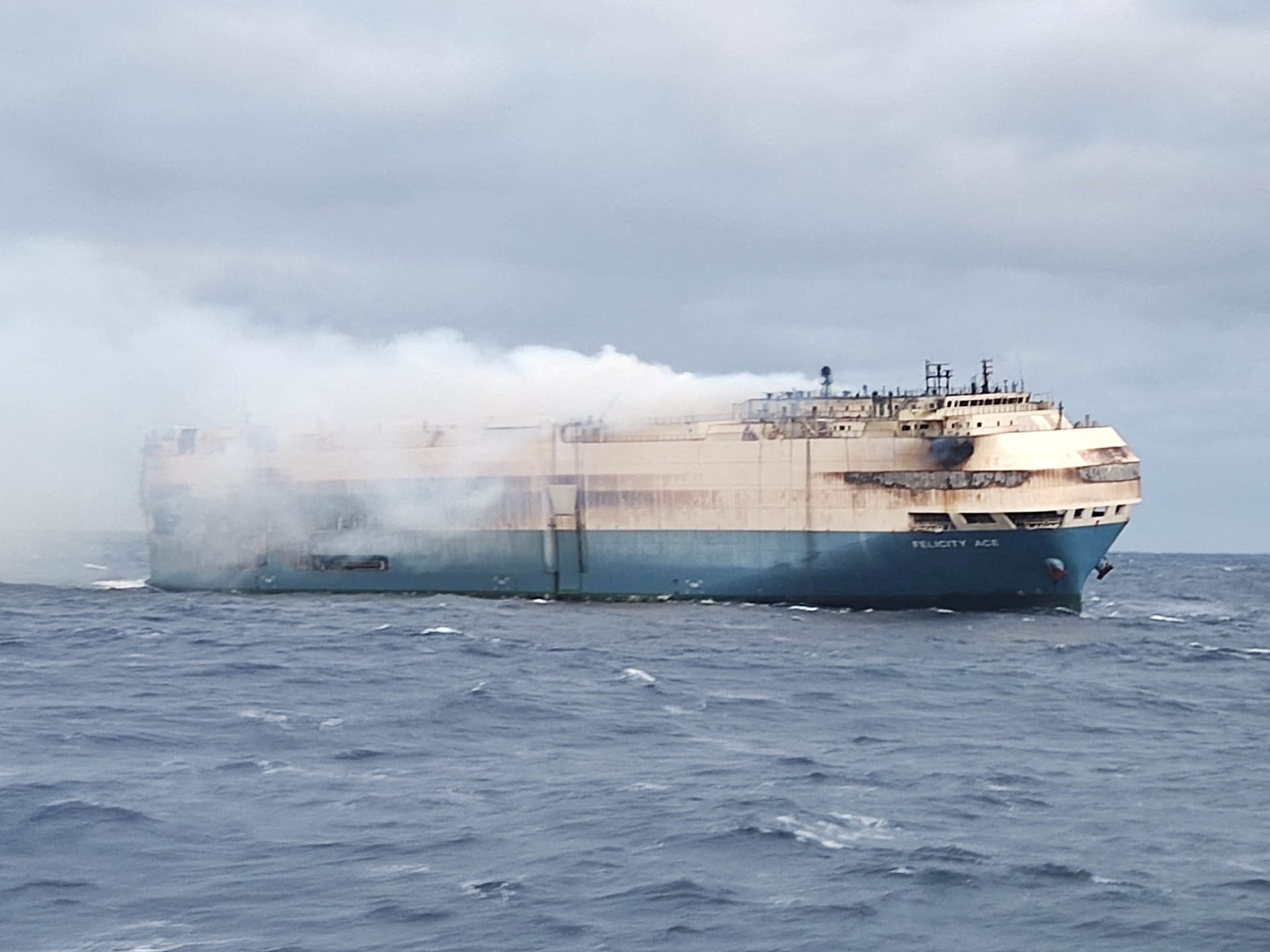search the site
Preventing Risk of Battery Fires in Shipping

The ship, Felicity Ace, which was traveling from Emden, Germany, where Volkswagen has a factory, to Davisville, in the U.S. state of Rhode Island, burns more than 100 km from the Azores islands, Portugal, February 18, 2022. Portuguese Navy (Marinha Portuguesa)/Handout via REUTERS
Preventing Risk of Battery Fires in Shipping
September 1, 2022
more and more electric vehicles (EVs) and battery-powered electronic devices are being transported by ships, highly inflammable lithium-ion batteries are increasingly impacting shipping safety.
This has been demonstrated by a number of fires on vessels, especially on roll-on roll-off (ro-ro) car carriers and containerships.
Recent incidents in which a battery fire was cited as a possible cause or contributing factor include the March 2022 fire and subsequent sinking of ro-ro carrier Felicity Ace. In the same month, the U.S. Coast Guard issued a safety alert about the risk posed by Li-ion batteries following two separate container fires. Earlier, in June 2020, a fire on the car carrier Höegh Xiamen in Jacksonville, Florida was attributed to a failure to properly disconnect and secure vehicle batteries. In January 2020, a fire on the container ship Cosco Pacific was attributed to the combustion of a Li-ion battery cargo which was not properly declared.
Given the many difficulties involved with suppressing battery fires, particularly at sea, focusing on loss prevention measures is crucial, whether batteries are transported within EVs or as standalone cargo, according to a new report from marine insurer Allianz Global Corporate & Specialty (AGCS) .
“Shipping losses may have more than halved over the past decade, but fires on board vessels remain among the biggest safety issues for the industry. The potential dangers that the transportation of lithium-ion batteries pose if they are not stored or handled correctly only add to these concerns, and we have already seen a number of incidents,” said Captain Rahul Khanna, Global Head of Marine Risk Consulting at AGCS. “Companies should do all that they possibly can to implement, develop and follow robust loss prevention measures, given the growing popularity of electric vehicles means many more vehicles with lithium-ion batteries will be transported by sea in future.”
Hazards and Causes
AGCS’ report, Lithium-ion batteries: Fire risks and loss prevention measures, in shipping highlights four main hazards: fire (Li-ion batteries contain electrolyte, an ignitable liquid); explosion (resulting from the release of ignitable vapor/gases in a confined space); thermal runaway (a rapid self-heating fire that can cause an explosion); and the toxic gases that these hazards can produce. The most common causes of these hazards are substandard manufacturing of battery cells/devices; over-charging of the battery cells; over-temperature by short circuiting, and damaged battery cells or devices, which, among other causes, can result from poor packing and handling or cargo shift in rough seas if not adequately secured.
“Batteries are not only a potential cause of fire if damaged, overcharged or subjected to high temperatures, they can also aggravate other causes of fire at sea and are difficult to extinguish as they have the potential to reignite days or even weeks later,” says Khanna. “In most shipboard incidents a thermal runaway event can be a significant possibility unless immediate action is taken by the crew, such as suppressing a fire with copious amounts of water over a long period of time. However, this can be extremely challenging due to factors such as early detection being difficult, a shortage of crew members on board, and if the vessel’s firefighting capabilities are inadequate.”
Loss Prevention Measures
The primary focus must be on loss prevention, according to AGCS. In its report, experts highlight a number of recommendations for companies to consider, focusing on two areas in particular: storage and in transit.
Among others, recommendations to mitigate the fire risk that can potentially result from Li-ion batteries during the transportation of EVs on car carriers and within freight containers include ensuring staff are trained to follow correct packing and handling procedures and that seafarers have had Li-ion battery firefighting training; checking the battery’s state of charge (SOC) is at the optimal level for transportation where possible; ensuring that EVs with low ground clearance are labelled as this can present loading/discharging challenges; and checking all EVs are properly secured to prevent any shifting during transportation. In transit, anything that can aid early detection is critical, including watchkeeping/fire rounds and utilizing thermal scanners, gas detectors, heat/smoke detectors, and CCTV cameras.
The report also highlights a number of measures that can help ensure safe storage of Li-ion batteries in warehouses, noting that large-format batteries, such as those used in EVs, ignite more quickly in a warehouse fire than smaller batteries used in smartphones and laptops. Among others, recommendations include training staff in appropriate packing and handling procedures; establishing an emergency response plan to tackle damaged/overheating batteries and a hazard control plan to manage receiving, storage, dispatch and supervision of packaged Li-ion batteries; preventing the exposure of batteries to high temperatures and ensuring separation from other combustible materials; as well as prompt removal of damaged or defective Li-ion batteries.
“If the maritime industry is to improve its incident record related to the transportation of lithium-ion batteries all parties involved in the supply chain must understand the hazards involved, the most common causes and the problems associated with transporting in commerce,” says Captain Randall Lund, Senior Marine Risk Consultant at AGCS. Captain Lund authored the report with fellow AGCS marine risk consultants Miguel Herrera and Justin Kersey.
“Regulations and guidance are specific in addressing these batteries to help prevent most incidents, but these can only be effective if they are communicated and enforced. Only through a concerted effort by stakeholders in the supply chain can we hope to reduce the rate of incidents,” Captain Lund said.


















